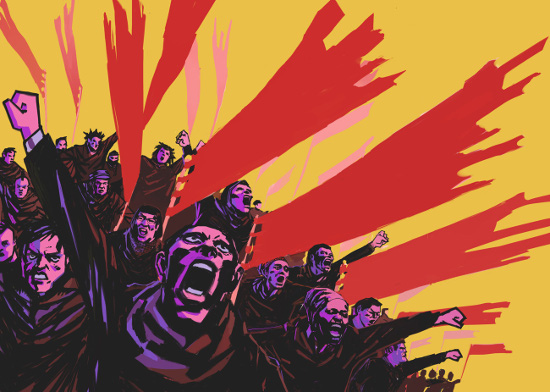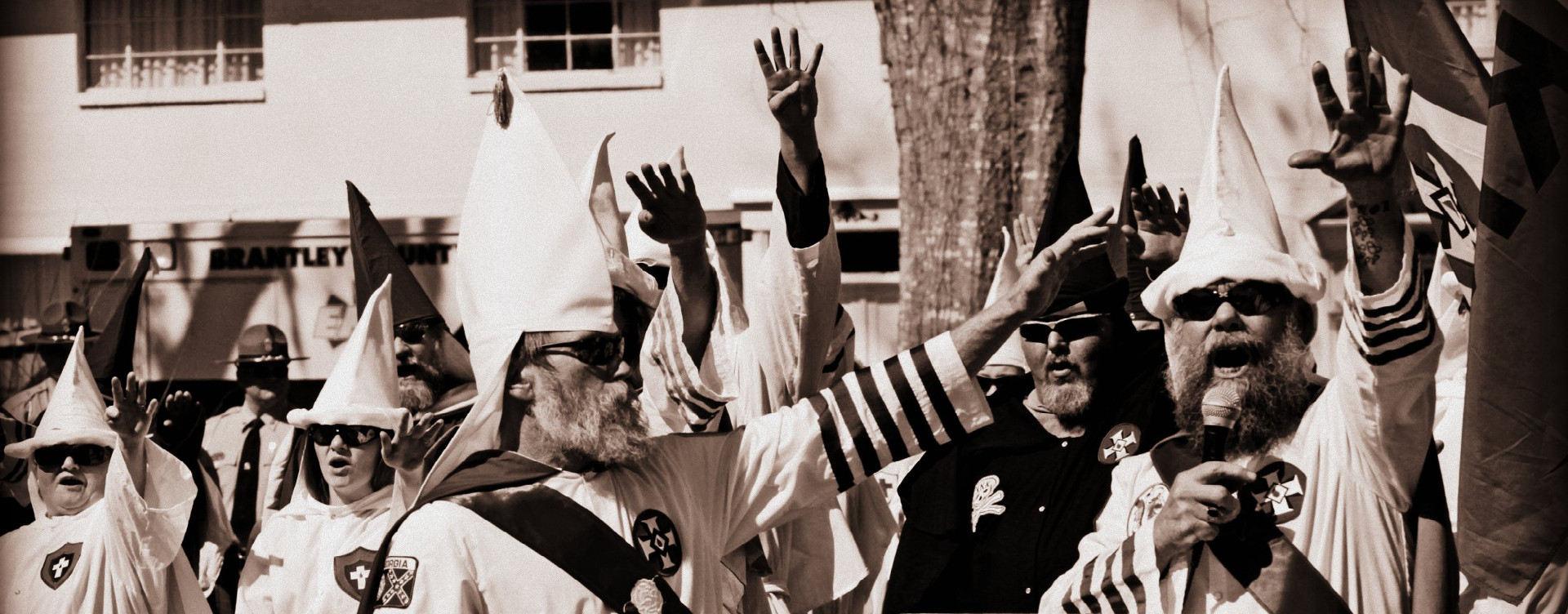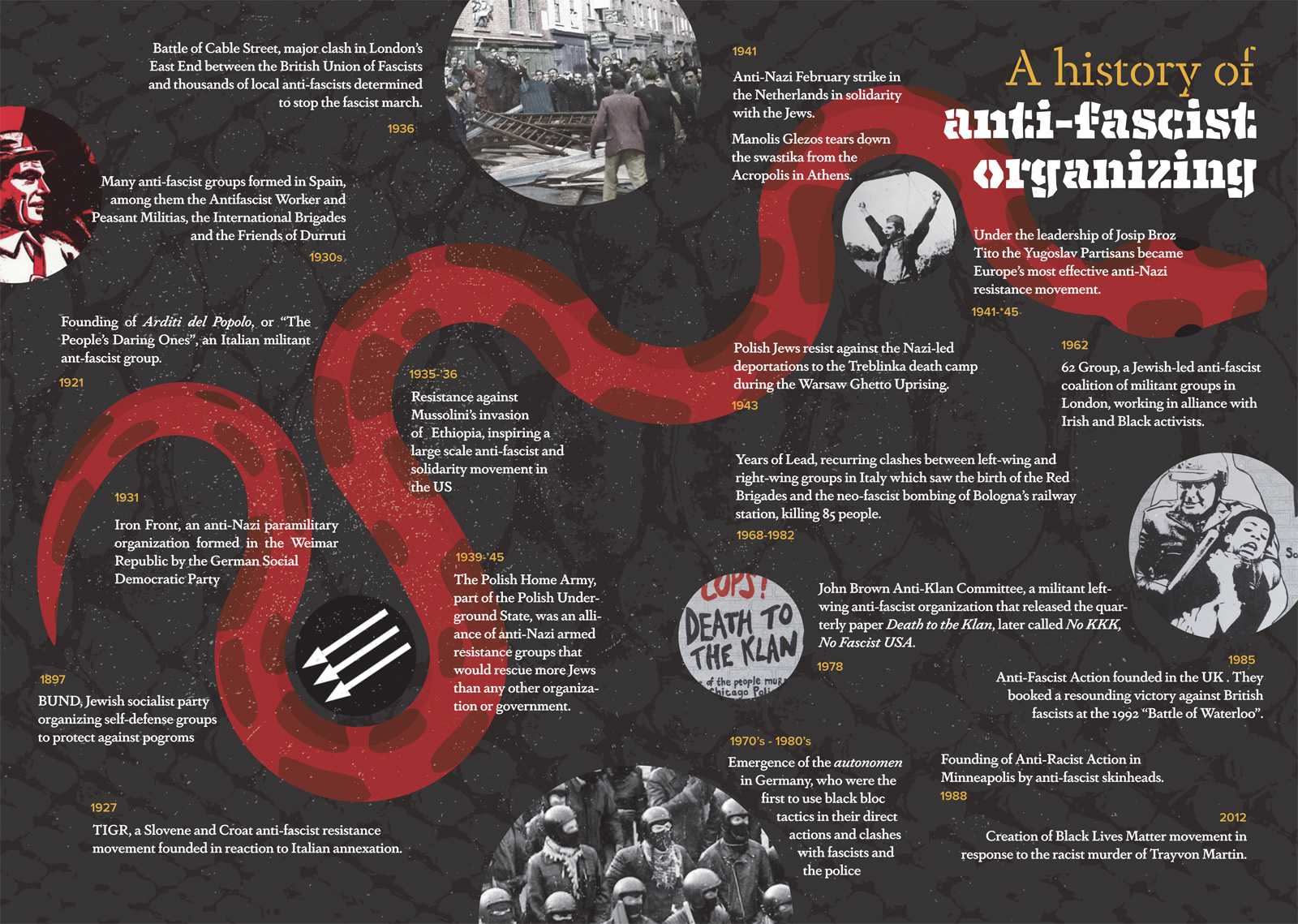The Fascist Creep
Fighting fascism requires that we recognize the complex ways in which the far right has taken up left-wing tactics and ideas.
Anti-Fascism and Revolution
- Issue #5
- Author
Does anti-fascism bear revolutionary potential? This question lingers in today’s tense climes — yet the precise meaning of “revolution” remains unclear. At the Conservative Political Action Conference in the United States this year, former UKIP leader Nigel Farage identified the successes of Brexit and Donald Trump as the beginnings of a “great global revolution.” Either Trump and Farage have joined the revolutionary left — or reality is far more complicated.
To understand the rise of Trump and Brexit, we would do well to return to the notion of the “national revolution,” which has over the years led many members of the working class to actively support, or at least passively acquiesce to, the gains of reactionary movements worldwide. Only by understanding the complex intersections between left and right can we begin to develop the analytical and tactical tools to prevent the creep of the working class towards fascist ideology, and to clarify the necessity of anti-fascist struggle against the very state-form as such.
The National Revolution
The antecedents of the fascist creep go back to the 1920s and 1930s. Before Hitler became Chancellor of Germany in 1933, his second in command, Gregor Strasser, led a powerful tendency in the Nazi Party that stressed affiliation neither with capitalism nor with communism, but with a “national revolution” favoring a United States of Europe — with workers’ syndicates functioning under a corporatist state within the ambit of national solidarity.
After the destruction of the Third Reich in 1945, the notion of the “national revolution” re-emerged as a dominant narrative of fascist ideology. Led in particular by Otto Strasser, Gregor’s brother, the so-called “Third Position” line held that Hitler had failed, but Nazism had not. For these so-called Strasserists, the leading fight of the postwar decades would be against NATO, which stood for the occupation of Europe by the United States and its ideology of liberal multiculturalism.
 As national liberation movements fought to gain independence from Europe’s colonial states around the world, members of Strasser’s coterie created a European Liberation Front, which would deploy direct action against NATO to “liberate” the continent from what they saw as a Jewish conspiracy against the racial purity of Europe. The discourse of anti-imperialism and “revolutionary traditionalism” became essential. Nazi war criminals joined Perón in Argentina and Gamal Nasser in Egypt, producing anti-Semitic propaganda and brokering arms deals. In 1956, Nasser reassured them by expelling some 25,000 Jews (half of Egypt’s Jewish community), and Ben Bella followed up on this after Algerian independence, forcing around 95 percent of Algerian Jews — some 130,000 people — into exile.
As national liberation movements fought to gain independence from Europe’s colonial states around the world, members of Strasser’s coterie created a European Liberation Front, which would deploy direct action against NATO to “liberate” the continent from what they saw as a Jewish conspiracy against the racial purity of Europe. The discourse of anti-imperialism and “revolutionary traditionalism” became essential. Nazi war criminals joined Perón in Argentina and Gamal Nasser in Egypt, producing anti-Semitic propaganda and brokering arms deals. In 1956, Nasser reassured them by expelling some 25,000 Jews (half of Egypt’s Jewish community), and Ben Bella followed up on this after Algerian independence, forcing around 95 percent of Algerian Jews — some 130,000 people — into exile.
The network of fascists that adopted national liberation as a guiding principle then began to infiltrate leftist networks and commit terrorist attacks against innocent civilians across Europe. They bragged that Maoist groups were easiest to infiltrate, due to their “impatience and zeal.” After May 1968, fascist ideologues adapted to the anti-authoritarian ethos of the new social movements, deploying Gramscian theories of cultural hegemony in the service of an ethnocentric movement that combined right-wing ideas with left-wing ones. More specifically, they insisted on the breakdown of modern nation-states into ethno-states federated under a “spiritual empire.”
White Nationalism and the Liberal Appeal
The impact of the mix between Third Position ideology and anti-imperialism found a reflection in the name of the American Nazi Party’s 1960s youth group, the North American Liberation Front, as well as the working-class rhetoric of its leading advocate, a young college student at Louisiana State University named David Duke. Attracting crowds to his regular white supremacist rants on campus, Duke garnered widespread media attention through controversial assertions of racial inequality and the need for authoritarian leadership. His media strategy worked: he would play the polite white guy, making appeals to common sense and reason amid fascist tirades designed to offend on more subtle registers. When leftists and non-whites intervened, he accused them of being “the real authoritarians.”
Duke’s style charmed reporters, but he soon realized the limits of open Nazism in US culture. Switching to the more American tradition of the Ku Klux Klan, Duke embraced the rhetoric of “white nationalism.” Rather than agitating for a Nazi overthrow of the US government, he seamlessly joined fascism with Klan-bred Americanism in an appeal to the public for “white rights.” White nationalism became the politically correct term for the “Klanazi” hybrid and its public discourse. For Duke, invoking democratic principles to forge a white ethno-state did not contain any contradictions, and too many liberals could accept the violent implications if the public presentation seemed respectable.
Over the next decades, former participants in Duke’s new Klan would develop the four pivotal strategic points for the modern fascist movement: “white nationalism,” “national revolution,” “leaderless resistance,” and social networks like Stormfront. These positions were first tested as fascists worked to conscript working-class subcultures like skinheads into the “frontline soldiers” of the “national revolution,” but the unpopularity of militant fascism led them to a strategy of infiltrating the right using the nascent militia movement as their host.
Relegating racism to the back burner and cloaking anti-Semitism in conspiracy theories, fascists used the militias as a breeding ground for ambiguous white nationalist politics aimed particularly against immigrants. Terms like “racially aware” came into use as white nationalists called their enemies “the real racists.” The rhetorical pattern of reversal served fascists’ attempts to call on liberals to denounce the left on the merits of universal applications of rights like free speech and assembly. Using the “I’m rubber, you’re glue” defense, fascists could even label their opposition “the real fascists” — and confused audiences would often agree.
The Current Struggle Against “Globalism”
After the defeat of the Soviet Union, the fascist movement around the world set its sights on “globalism” and the New World Order (NWO). For fascists, “globalism” combines liberal multiculturalism, sexual permissiveness and religious tolerance. Their hatred of globalism drove US fascist leaders to express admiration for the famous anti-WTO riots in Seattle in 1999, and they ironically supported, at least in part, the 9/11 attacks as bold strikes against the New World Order.
By tying “globalism” in with capitalism through the critique of globalization, the far right entered the largely left-wing anti-globalization movement. Fascists infiltrated anti-globalization groups like Campo Antimperialista and joined online networks utilized by the left like Indymedia, leading to an influx of conspiracy theories and anti-Semitism masquerading as “anti-Zionism.”
At the same time, the far right in the US boosted fascist infrastructure by supporting Islamophobic “experts” and a network of groups like Stop the Islamization of America, Stop the Islamization of Europe, and Patriotic Europeans Against the Islamization of Germany (Pegida). Thus, anti-globalism fused the rejection of globalization with anti-Semitic conspiracy theories and the hatred of migrants in order to continue the “national revolutionary” struggle against NATO into the post-Soviet era.
Moreover, through the strategy of “leaderless resistance,” fascist networks became increasingly decentralized, joining Islamophobic marches and increasingly deploying predominantly left-wing tactics like black blocs against anti-fascists and police. After the financial crisis, such formations increasingly aligned with Putin’s Russia and against the European Union and NATO, blaming the EU for the combination of increased immigration and fiscal austerity. Because they reject the EU and NATO for similar reasons, a number of radicals, liberals and leftists have chosen to join the side of Islamophobic groups or aid the “anti-globalist” movement. We will see how these unfortunate marriages take shape with the help of a just a few brief examples.
1) Anti-imperialism
It is now rather well known that, in December 2014, two left-wing groups from the US — United National Antiwar Coalition and the International Action Center — joined a host of far-right and fascist separatist groups in Moscow for an anti-imperialist “Multipolar World” conference. Whether or not they knew about the convergence of fascist and leftist Euroscepticism at the conference ahead of time, these groups participated in the same spirit as those on the radical left in the UK who supported Brexit.
Left-wing formations like the Workers World Party, Party for Socialism and Liberation, and the Workers Party have similarly thrown their support behind Bashar Al-Assad’s authoritarian regime in Syria, in support of Russia’s interests in the region as opposed to America’s “deep state.” This illiberal reasoning that “an enemy of my enemy is my friend” puts these groups in an awkward place with regards to fascists’ coeval support for the Kremlin and Assad.
2) Decolonization
In another exposition of solidarity among separatists, the French-Algerian decolonial thinker Houria Bouteldja recently encouraged her supporters to observe the ideological proximity between anti-Semitic comedian Dieudonné, fascist Alain Soral and immigrants. “[I]f we were to consider the political offer that Dieudonné and Soral embody,” she wrote, “it is currently the one that best conforms to the existential malaise of the second and third generations of post-colonial immigrants: it recognizes full and complete citizenship within the nation-state, it respects the Muslim character within the limits and conditions put forth by Soral. It also designates an enemy: the Jew as a Jew, and the Jew as a Zionist, as an embodiment of imperialism, but also because of the Jew’s privileged position.”
Rejecting left and right and designating feminism as Eurocentric imperialism, Bouteldja — who is published by the left-wing Fabriques and whose work has appeared in the American socialist magazine Jacobin — ascribes a certain affinity with fascists to immigrants, or “indigènes,” that trumps the extant mainstream left. While clearly not representative of the broad spectrum of decolonial thought, Bouteldja’s position expresses the tendency of some to join with fascists in the struggle against liberalism, rather than acknowledge fascism as a common enemy.
3) Eurocommunism
During the most pivotal period of the Syrian refugee crisis, the left could not muster a united rejection of Islamophobia, reminding many of the tragic history of revisionist Eurocommunism in the 1970s and 80s. As Communist Parties in Western Europe failed to adapt to deindustrialization and the counter-cultures of the 1960s, they developed “Eurocommunism,” which insisted on preserving presumed “authentic European values” like parliamentarianism against the Soviet Union’s encroachment. Many within this movement became virulently hostile to immigrants. On one notorious occasion, the Communist Mayor of Vitry in France led a large protest against immigrants, driving a bulldozer into a guest worker asylum. Coupled with neoliberal reforms under the Socialist Party in the 1980s, Eurocommunism signaled the decline of the left and the rise of the radical right populist party, the Front National.
Particularly reminiscent of this trend in 2016 was the attitude of leftist thinkers like Slavoj Žižek, who insisted that “European values” associated with the Enlightenment must be protected against unassimilated Muslims and Syrian refugees. Rather than just advocating the superiority of European civilization, however, Žižek insists that “I don’t think too much integration is good… I want polite ignorance.” For Žižek, Muslim “lower classes” actually envy European civilization and must be “educated (by others and by themselves) into their freedom.” According to Žižek, the “only consequent truly leftist position” is more forceful imposition of Eurocentrism alongside “a degree of distance” between Muslims and non-Muslims. True to form as one of the world’s leading contrarians, Žižek applies liberal thought toward utterly illiberal conclusions.
While Žižek joins the far right in presenting the unintegrated Muslim migrant as an immediate threat to the European Enlightenment, Bouteldja ascribes far more dignity to the unassimilated. However, both link unassimilated migrants to fascism. While Bouteldja suggests the ultimate shattering of Eurocentric universalism in league with anti-Semitic reaction, Žižek asserts Eurocentric universalism against Muslims. Both, however, capitulate to one degree or another to the “ethno-differentialism” advocated by fascists who — as with Soral’s link to Bouteldja and Žižek’s “degree of distance” — hope to maintain geographical and cultural boundaries separating “European culture” from non-white obtrusion.
Rather than attempting a synthesis of Žižek’s critical liberalism and Bouteldja’s anti-Enlightenment tradition, which would likely take the form of something approximating white nationalism, anarchists and anti-authoritarians would do better to put both aside, insisting instead on an internationalism that overcomes ethnocentrism as well as the racist, colonial and imperialist tendencies of the European Union.
The Rise of the Alt-Right
It was amid these intersections between left and right that the American neo-Nazi Richard Spencer created the alt-right movement and took over the paleo-conservative National Policy Institute. Seeing himself as a pioneering “hipster-whisperer,” Spencer gave old white nationalism a makeover by deploying the same tropes composed by the aforementioned leftists, radicals and liberals.
He argued for white identitarianism, assuring people like Bouteldja’s indigènes a certain place within the anti-liberal ethnocentric reconfiguration of the world. He asserted that unassimilated Muslims pose an essential threat to superior European values and wrote that “Slavoj Žižek is my favorite leftist. He has more to teach the alt-right than a million American conservative douches.” He also openly supported Putin’s Russia and used anti-imperialist rhetoric to advocate “multipolar” Euroscepticism. Spencer’s alt-right was thus placed at the intersection of illiberal sentiment while paradoxically deploying the usual universalist reversals to encourage disgruntled liberals to join in.
Generating a quasi-mass movement through internet memes, message boards and podcasts that produced networks with other traditionalists, white supremacists, Men’s Rights activists and neo-reactionaries from Silicon Valley, Spencer led his constituents into a hegemonic bloc with Trump supporters, suffusing extreme-right populism with a new fascist synthesis. Using Trump as a figurehead, Spencer centralized the basics of fascism within the US far right while encouraging people to appreciate left-right syncretic understandings. Though Trump appeared to turn against the alt-right, it would appear he has only normalized much of it.
Trump’s chief strategist, Breitbart founder Stephen Bannon, endorses Catholic traditionalism developed in relation to the thought of fascists like Julius Evola and Alexander Dugin. Together with his admission of a Leninist desire for revolution, Bannon’s ideology bears the markings of a “revolutionary traditionalism” that would feel at home on Stormfront. Other Trump affiliates are linked to the white nationalist Tanton Network.
Yet the Trump administration seems weak in many places — not only with regards to inquiries into its suspicious dealings with Russia but also in light of the recent women’s march and strike, and the mass protests against his Muslim bans. In general, hegemonic white nationalism seems unstable and increasingly susceptible to challenges from below.
The struggle against Trumpism is commensurate with the struggle against fascism and the struggle against the state. There is a need for the left to exploit the weaknesses of Trumpism, assemble into autonomous groups and determine clear positions against fascism as well as localized strategies on building power through a grassroots countermovement to the encroachment of the far right. Fighting fascism through top-heavy efforts will only repeat the errors of authoritarian self-destruction. Yet if Trump is unseated through impeachment or whatever means, anarchists and anti-authoritarians will have a better opportunity to expose the crisis of the state-form and help create spaces based on principles rather than statism.
Fascism can be overcome through militant organization, through autonomous self-activity and everyday resistance, through community organizing and international coalition building, through artistic and cultural praxis, and through the persistent enfranchisement of freedom and equality at all levels of society. Let no ground be ceded to the fascist creep!
Source URL — https://roarmag.org/magazine/fascist-creep-antifascism-revolution/
Next Magazine article
A Dozen Shades of Far Right
- Maik Fielitz, Laura Lotte Laloire
- April 2, 2017
Fight to Win
- Erik Forman
- April 2, 2017



